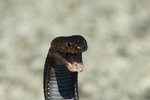
Vipers are poisonous snakes characterized by hinged fangs and powerful venom. The viper family contains many different types of snakes, including multiple rattlesnake species, the copperhead snake, the African bush viper, the jararaca and the cottonmouth. Vipers tend to eat what they can catch, but the specifics of their diets depend on where they live, how big the individual snake is and the relative size of the prey.
A Variety of Rodents
Rodents are a common prey for vipers. Very small vipers, usually youngsters, prey on newborn mice or rodents who are still quite little -- the prey must be small enough for the snake to swallow. Vipers also eat adult mice and rats, chipmunks, squirrels, voles and even prairie dogs if they’re the right size. Snakes such as the Gaboon viper, Bitis gabonica, hide among the leaves on the forest floor and wait for rodents to get close enough, then strike and kill with lightening speed.
Small Mammals
Vipers will make a meal of most small mammals that cross their paths, as long as the size is right. They commonly eat rabbits, bats, shrews and moles. Rattlesnakes such as the western diamondback rattlesnake (Crotalus atrox), consume many types of small mammals in addition to the rodents they usually eat, and will catch and eat whatever small prey is available in the particular snake’s environment. Vipers can swallow prey that’s as much as 20 percent of the snake’s own body size, so an 8-foot snake is capable of consuming many types of mammals.
Reptiles and Amphibians
It’s common for vipers to eat lizards and other reptiles. Most adult members of the viper family also eat smaller snakes, including other vipers of the same species. The younger, smaller snakes of some species, like the African bush viper, Atheris squamigera, consume more reptiles than the adults do, along with various insects; and they graduate to other prey animals as they get older and larger. Frogs are another common prey item for vipers. For snakes who live near frog habitats, frogs are an important part of their regular diet.
Ground and Tree Birds
Snakes eat birds when they can catch them. Some, including the eyelash palm pit viper (Bothriechis schlegelii) lie in wait along the branches of trees and strike when birds approach them. Good camouflage makes it easier for many vipers to disguise themselves and deceive their prey. Other snakes, such as Brazilian pit vipers (Bothrops jararaca) and the southern copperhead (Agkistrodon contortrix), can also use the end of their tails as lures. The tip of the snake’s tail looks like insect larvae, and he will dangle it to trick birds on the ground or in the trees into getting close enough for the viper to grab his meal.
References
- University of Michigan Animal Diversity Web: Gaboon Adder
- Encyclopedia of Life: Eyelash Palm Pit Viper
- North Carolina University Cooperative Extension: North Carolina Venomous Snakes
- Discover Life: Southern Copperhead
- San Diego Zoo: Reptiles: Snake
- University of Michigan Animal Diversity Web: Jararaca
- University of Michigan Animal Diversity Web: African Bush Viper, Rough-Scaled Bush Viper
- University of Michigan Animal Diversity Web: Western Diamond-Backed Rattlesnake
Photo Credits
-
Jupiterimages/Photos.com/Getty Images




